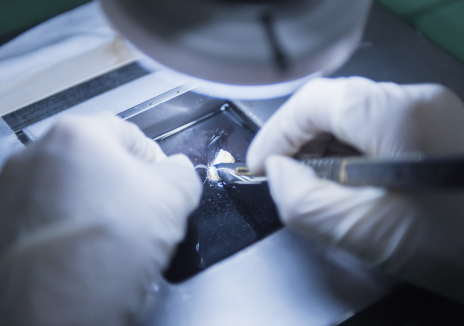Non-incisional Hairline Correction
A method of collecting and transplanting the root part of each hair follicle by follicle using a small cylindrical micro-drill that holds 1-2 hairs

STEP 1
Transplant site design

STEP 2
Design and disinfect the collection site

STEP 3
Collection site anesthesia

STEP 4
Non-Incisional follicle collection

STEP 5
Aqua cutting and microscopic follicle separation

STEP 6
Partial anesthesia at the transplant site

STEP 7
Creating transplant pores with slits

STEP 8
Follicle transplant

2007
Developing an enhanced non-incisional method
Minimize non-incisional scarring using an enhanced non-incisional punch
Smaller punches can damage collected follicular cells, and larger punches can leave more scarring than necessary.
By using a punch size optimized for your scalp, it minimizes scarring and enables collecting the right amount of follicular tissue.



Engraftment rate↓

Engraftment rate↑
Why does the perifollicular tissue need to be thick?
The less tissue around the follicle, the more susceptible it is to external influences.
This is because there is less cushioning. Less tissue around the follicle makes it more vulnerable to external shock and increases dryness, which is one of the biggest causes of poor engraftment rates.
A non-shaving, non-incisional method that is invisible the day after surgery
Typically, a non-incisional hairline correction involves a full or partial haircut to facilitate the collection of hair follicles.
A non-shaving, non-incisional hairline correction is a hair transplant that does not require a haircut before the procedure and is performed with partial or no shaving.
It is the most invisible method of hairline correction because it uses the large area of the occipital region evenly, causing the least damage to the collection area. And there is no difference in density between the collection and non-collection areas
Non-incisional method

Before pre-cutting

After pre-cutting

The day after surgery (after shampooing)
If there's even a 1% chance of doing something better,
we pursue it, no matter how much effort and cost is required.
-
 SlitEngraftment is higher when the maximum number of hair follicles are transplanted into the minimum number of pores.
SlitEngraftment is higher when the maximum number of hair follicles are transplanted into the minimum number of pores. -
 Use a high-magnification microscope throughout the processUsing a high-magnification microscope can increase the number of healthy follicles by 25% over visual isolation.
Use a high-magnification microscope throughout the processUsing a high-magnification microscope can increase the number of healthy follicles by 25% over visual isolation. -
 Underwater isolation aqua cuttingHair follicles are damaged after only 60 seconds of exposure to air. Underwater isolation minimizes damage to the hair follicle compared to airborne isolation.
Underwater isolation aqua cuttingHair follicles are damaged after only 60 seconds of exposure to air. Underwater isolation minimizes damage to the hair follicle compared to airborne isolation. -
 Cold moisture retention deviceKeep collected follicles at 4 degrees until just before transplant to minimize heat damage to the follicles
Cold moisture retention deviceKeep collected follicles at 4 degrees until just before transplant to minimize heat damage to the follicles -
 Organ preservation solutionThe same organ preservation solution used in liver and heart transplant surgeries is used to keep hair follicles healthy until transplant
Organ preservation solutionThe same organ preservation solution used in liver and heart transplant surgeries is used to keep hair follicles healthy until transplant -
 Hyperbaric oxygen therapy for effective care after transplantMaintain healthy hair follicles for 12 months with 3 days of effective post-transplant care
Hyperbaric oxygen therapy for effective care after transplantMaintain healthy hair follicles for 12 months with 3 days of effective post-transplant care





 Join
Join Login
Login


 EN
EN











 Check out the effect with the video
Check out the effect with the video